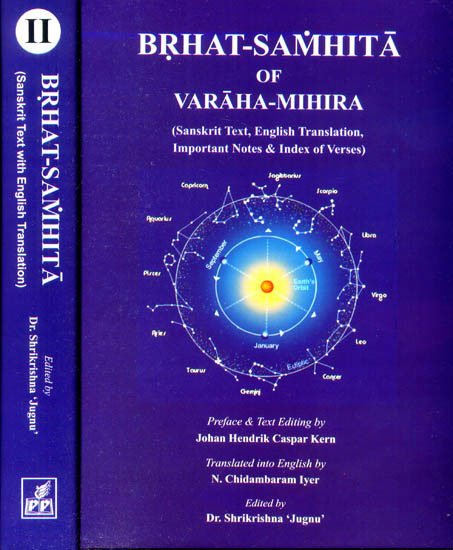Brihat Samhita
by N. Chidambaram Iyer | 1884 | 135,584 words | ISBN-13: 9788171104215
This page describes the wagtail (khanjana-kalakshana) which is the forty-fifth Chapter of the English translation of the Brihat-samhita. This work, written by Varahamihira in the 6th century, is classified as jyotisha literature, also known as Indian astronomy. It contains however, also content regarding astrology, palmistry, agriculture, gardening, perfumes, medicines and various other encyclopedic topics.
Chapter 45 - On the Wagtail (khañjana-kalakṣaṇa)
[Sanskrit text for this chapter is available]
Note: This bird is known as Khañjana in Sanskrit. It is a species of wagtail. Mounta alla, Alba.
1. I shall here state the effects of the first appearance of the bird known as Khañjana (wagtail) on the king’s march as stated by Ṛṣis.
2. If the bird be one of the species possessing a large body and a long and black neck, it is known as Bhadra; it forebodes good-luck; if it be one of the species black up to the neck or face, it is known as Sampūrṇa; it forebodes success.
3. If it be one of the species with a dark spot in the neck and with white cheeks, it is known as Rikta; it forebodes evil. If it be yellow, it is known as Gopīta; it also forebodes evil.
4-6. If it be seen on trees of sweet fruits and fragrant flowers or close to sacred water, or on the heads of elephants, horses and serpents, on the tops of temples and on the king’s palace, in flower gardens or on the mansions of the rich; near cows, cow-pens, gatherings of Sādhus or holymen, sacrificial fire-sites, festival places, kings, Brāhmaṇas, elephant-sheds, horse-sheds, an umbrella, a flag-staff, a Cāmara and the like; near gold, white cloth, places adorned with the lotus and the water lily, in places washed with cow-dung, on vessels containing curdled milk or on heaps of grain, it forebodes prosperity to the king.
7. If it be seen near swampy places, the king would eat sumptuous meals; if on cow-dung, he will get a good supply of milk and curd; if on green turf he would get good cloths and if on chariots, he would leave his kingdom.
8. If it be seen seated on the tops of houses, the king would lose his wealth; if on snares, he would be imprisoned; if on impure places, he would suffer from disease; and if on the back of the sheep, he would soon obtain his desired object.
9. If it should be seen seated on the back of a buffalo, a camel, an ass, on the bones of animals, on cremation grounds, in the corners of houses, on pebbles or gravels, on rocks, on the walls of towns, on ash or on hair, there would be deaths, diseases and fears in the land.
10. If it should be seen when it is shaking off its wings, there would be misery in the land; if when in the act of drinking water from the river, there would be prosperity; there would also be prosperity if seen about sunrise; and if about sunset, there would be misery in the land.
11. If the king should march in the direction in which the wagtail should be seen to fly immediately after the Lustration ceremony is over, he would triumph over his enemies.
12. Where the wagtail should be seen to copulate, there would be treasure in the ground under; where it should be found to vomit, there will be crystal beads in the ground under it; where it passes stool, there would be found charcoal under ground; these may be found to be the case on actual examination.
13. If the wagtail should be found dead, the king would die; if of broken limbs, the king would suffer similarly; if covered with wounds, a similar fate will befall the king; if found to enter its nest, the king would get wealth and if perceived in its flight his relatives will visit him.
14. If the king should chance to see in some pure spot a wagtail foreboding good, he shall then and there perform pūjā on the ground with sandal paste, flower and perfumed smoke; he is then sure to prosper.
15. If he should chance to see a wagtail foreboding evil, he shall perform pūjā to Brāhmaṇas, preceptors, yogins and the Devas; he will escape the evil effects. He shall abstain from meal for seven days.
16. The effects of the first appearance of the wagtail will come to pass within a year; if during this period the wagtail should be seen again, the effects of such second sight will come to pass that same day before sunset. In making predictions from the wagtail the astrologer shall take into account the direction of its flight, its place, body, the rising Zodiacal sign at the time, the Nakṣatra or the Moon’s place at the time, and whethér the bird is seen with its face turned to the sun or away from the sun.
